It’s review season again! Theros Beyond Death offers us some new toys for cube owners and I’m excited to get into it with you.
First, Sagas are in fact back. Sagas play out well and their countdown mini-games excellent for limited. There are certainly a few new ones in Theros Beyond Death that have exceeded my expectations after some testing.
In addition we have a fistful of new enchantment gods, remixed from their original incarnations. And perhaps the most important of all is Escape, which has proved itself to be far above even my highest expectations. As it turns out, spells you can cast over and over again—even with some restrictions—can feel broken.
Then there’s constellation, or enchantments-matter. This is the (relatively) parasitic mechanic of the set. Most of these cards won’t make it into our cubes without serious commitments to supporting the archetype. As such, I’ll only be touching on cards which hold an inherent power level and don’t rely on too much on synergy. However, it’s possible that Theros Beyond Death has opened up the possibility of an enchantments-matter archetype in rarity restricted cubes.
I will not be giving out letter grades, but I’ll rate my top cards at the end of the article. We’ll be going in WUBRG color order, then Multicolor and Colorless.
Don’t miss my previous review of White and Blue.
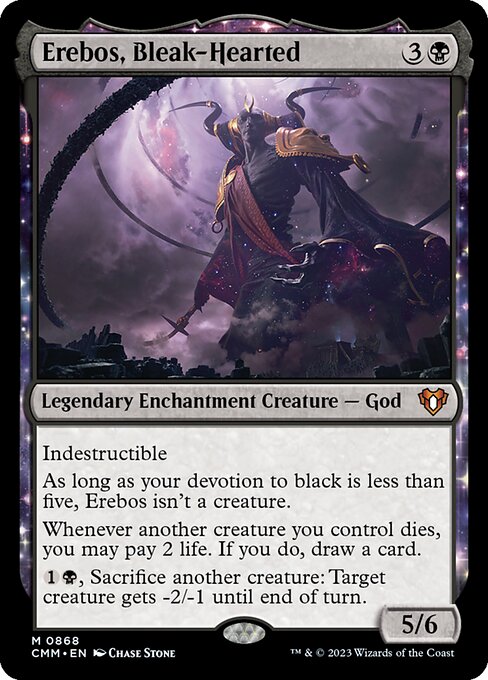
Erebos, Bleak-Hearted
There’s a running theme here with the new Theros gods and with every week of these reviews I can’t help but to reiterate it—evaluate them as enchantments first, not creatures. Devotion to five doesn’t look like a lot on paper, but for most games of interactive Magic getting to five pips on the battlefield is going to be a challenge. Waking up your god is a bonus but never a guarantee.
That being said Erebos, Bleak-Hearted has abilities that can potentially pay serious dividends when your life total isn’t under seige. Paying two life to draw a card each time one of your creature dies is decent, even pretty good in the right matchup, but is ultimately unacceptable when you have to spend an entire card to start getting value. It’s slow, clunky, and doesn’t affect the board right away; an expensive and downright terrible version of Arguel’s Blood Fast, except you can’t just pay life willy-nilly to start drawing extra cards. You’ll need creatures to either die or to sacrifice.
Erebos struggles to present themselves as a meaningful engine for winning games, even when the two abilities are considered in concert. The activated ability allows us to either trade off one of our creatures for an opposing smaller creature, or threaten to make combat a nightmare for the opponent so long as we have a board presence. This might be excellent in a game of retail limited where removal is precious and board presence is the ultimate metric, but for cube it’s barely convincing, even when considering best case scenarios.
Compare Erebos, Bleak-Hearted to Midnight Reaper or Liliana, Dreadhorde General. These other cards affect the board meaningfully, can even warp the game around themselves—more so for the Planeswalker—and have similar text to what Erebos is promising to do. They all benefit from creatures dying, but Midnight Reaper and Liliana are also worth a card inherently. This is important, especially in the games we’re playing from behind, so we can’t expect to spend four mana on an enchantment that doesn’t have an immediate impact. This is 2020. We can do better.
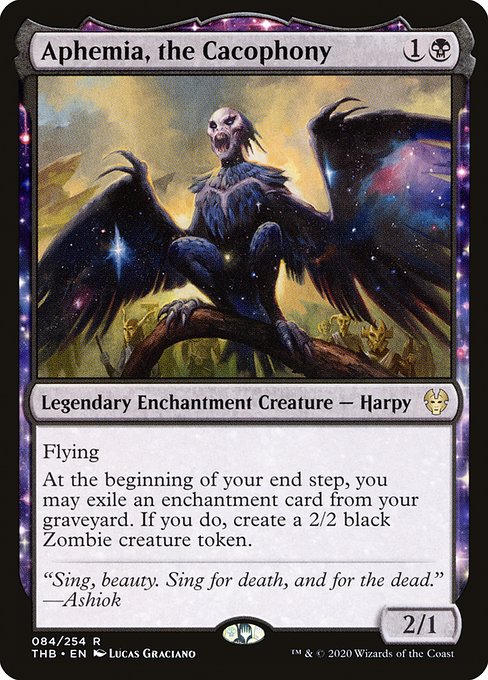
Aphemia, the Cacophany
I was initially skeptical to test Aphemia, the Cacophany. A 2/1 flier for two mana is, as a baseline, a desirable set of stats for a black aggressive deck but isn’t exactly bringing home the bacon. I think I was completely blindsided by Aphemia’s static ability; I just couldn’t make sense of it—except that it felt parasitic, which skewed my initial evaluation of the card entirely. What hoops do I have to jump through to make this card merely play as intended? Is the upside on Aphemia even worth the damn trouble?
I duped myself through card misevaluation. By focusing too much on one half of the card I had failed to see Aphemia for what they actually are: an efficiently-costed evasive beater with a bit of marginal upside. Simply having access to another cheap evasive creature will help aggressive decks achieve that critical mass of early pressure. And as for the zombie-making? After some quick research, fueling this ability has a surprisingly manageable opportunity cost. Gnarled Scarhide, Herald of Torment, Dead Weight, Mire’s Grasp, and Seal of Doom slide themselves quite naturally into my environment. These enchantments function perfectly well in of themselves, playable even without Aphemia—though admittedly filling their slots less than ideally, especially for those removal spells.
I’ve found that making on average one zombie per game has been excellent and well worth the cost of tuning my Black section to incidentally accommodate Aphemia. But here’s the real meat of it: if you support Black aggro in your cube then Aphemia is just a good card anyway. Aggro decks need these evasive creatures to attack through slower decks and pressure opposing Planeswalkers; Aphemia not only does the job but will sometimes even bring along some friends. What’s not to like?

Eat to Extinction
For those of us who remember the days before Murderous Rider there was only Hero’s Downfall, and sometimes there was even Vraska’s Contempt. Contempt was begrudgingly playable at best, a necessary evil in Planeswalker-heavy environments. It checked the boxes and even gave you a little life for your troubles. But it always felt too hard to cast, too much a cost to hold up except specifically in Dimir alongside counterspells, and once Murderous Rider showed up it was (thankfully) as if Vraska’s Contempt had never existed.
Enter Eat to Extinction. This is, simply put, strictly better than Vraska’s Contempt in nearly every way. Eat is easier to cast and tacks on Surveil 1 instead of gaining two life, which for about 95% of games is a serious upgrade. If your cube is larger and needs redundancy on Planeswalker removal, Eat to Extinction makes the cut, but just barely. Four mana is still a lot to trade for a permanent that has likely already given it’s controller some value. But it’s what we have to work with, so we make do.
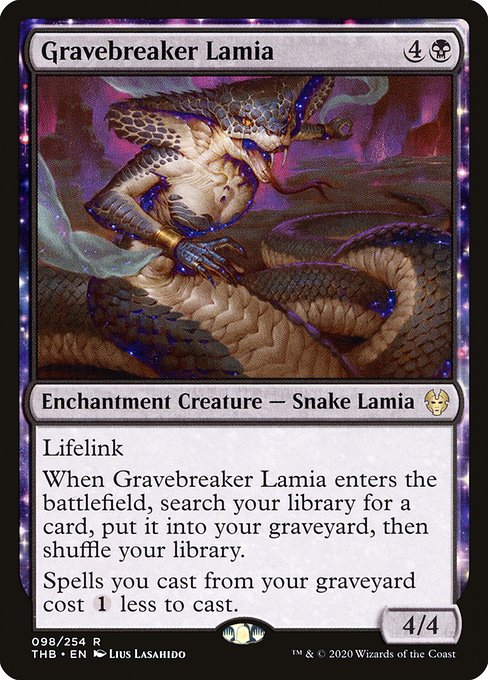
Gravebreaker Lamia
I was unreasonably excited to test this card, and I’m glad I did. Entomb is a very powerful enter the battlefield effect on a creature; the agency to tutor up a fatty or critical combo piece into the graveyard while stabilizing a board state is a fine deal on paper. However, Gravebreaker Lamia is simply too expensive for any seriously committed reanimator archetype. Once you cut out all the hyper efficient ways we have to put cards into your graveyard, cards like Bazaar of Baghdad, Entomb, Putrid Imp, and even Collective Brutality, the Lamia can only be taken seriously as a value play and not a combo enabler.
The discount we get on casting cards from our graveyard is basically never relevant. Once we get to five mana we’re already casting our Flashback or Escape cards comfortably, so the discount doesn’t really impacting the game meaningfully. I think we should stick to the robust enablers already available to us and not have to tread into Gravebreaker Lamia territory for our value plays.
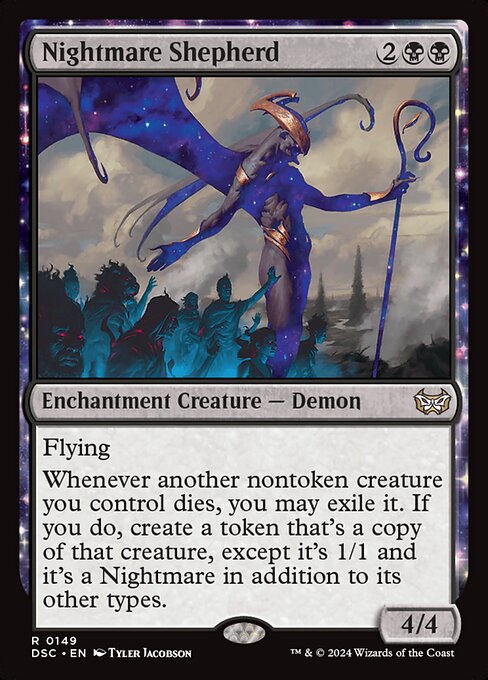
Nightmare Shepherd
Nightmare Shepherd had me salivating when it was spoiled. I have a soft spot for Birthing Pod-style decks, so upon seeing this card I gleefully imagined the potentially broken amount of ETB triggers in my midrange creature decks. Nightmare Shepherd sure as shit teases us with some crazy gamestates and is no slouch on the battlefield being a 4/4 flier for four mana. This is a great rate for retail limited, and good for cube, but I couldn’t help but feel that fog of misevaluation creeping in and dizzying my expectations.
Yes, the potential for this card is extraordinary, but Nightmare Shepherd doesn’t inherently do anything besides attack and block. It’s an A+B card, sometimes even A+B+C; threats that don’t get value coming in have a hard time justifying their mana investment. In other words, Nightmare Shepherd needs a lot to go right to get it’s value in cube. Consider this, and the already tight four drop creature slot and ask yourself if you’d rather have a Ravenous Chupacabra or a Nightmare Shepherd. Most of the time, and for most drafters, you’ll want consistency over variance.

Woe Strider
Woah.
This card was heralded early on by some as “the best card in the set for cube.” While it hasn’t exactly lived up to such a ridiculous prediction, it still justifies itself as a solid role player. A free sacrifice outlet and a recursive threat on one body, Woe Strider is excellent at grinding. You’ll be hard pressed to find this much value on your Black three drop: whether you want to set up persist combos, finish an opponent off in concert with Blood Artist, or mitigate the card disadvantage of discard effects, Woe Strider fits into most fair and some unfair Black strategies. While I haven’t been overwhelmed with excitement by this card, it has yet to disappoint me, and that kind of consistency is hard to chuckle aside.
Elspeth’s Nightmare
In case you didn’t hear, Sagas are back! Elspeth’s Nightmare is quite simply Swat, Duress, and then Nihil Spellbomb (without the Kicker) and that’s a good bit of value for three mana. In rarity-restricted cubes this is a rock solid midrange or control card, one that can even clear the way for later stabilizing threat. If you can recur this from the graveyard or count it towards delirium well, then all the better. I like what this card represents and while it’s maybe a step down from The Eldest Reborn, is cheaper to cast and should always have some relevance.
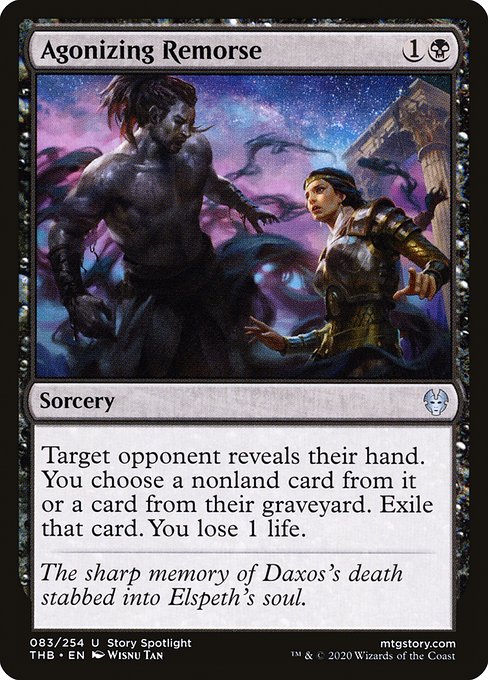
Agonizing Remorse
Playable two mana hand disruption spells are scarce and sometimes we find ourselves trying to make fetch happen. Even since the printing of Collective Brutality some cubes also bothered to run Distress, so I’m happy to report we now have a bit of card obsolescence on our hands. While in Theros Beyond Death limited Remorse is almost never a bad draw, in cube the agency to interact with the opponents graveyard is mostly flavor text. That is, until that game comes up when you rip Remorse off the top of your deck and still have a target.
This card is a welcome addition to Black’s discard suite: it’s unconditional, easy to cast, and as stated above has some unique functionality. I’m a huge fan of discard effects all the way up to powered Vintage cube, so I wouldn’t be surprised to see this card make it’s way into a lot of lists.
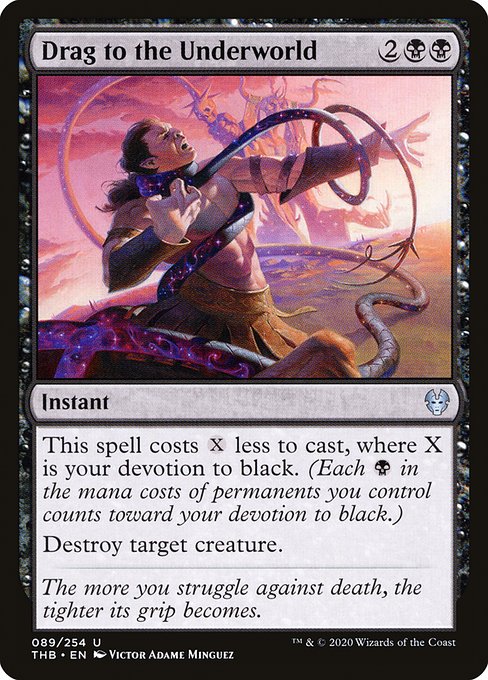
Drag to the Underworld
There’s not terribly much to say about Drag to the Underworld as it’s a pretty clean design. It’s unconditional removal that’s sometimes easier to cast, and slots in perfectly to Peasant cubes of all sizes. I think the variance on its casting cost restricts Drag from higher power levels where, for example, we can play Eat to Extinction in addition to all the excellent two and three mana plays. But if your rarity restricted cube is big enough, over 540 is my guess, I think Drag becomes a fine option for almost any Black deck.
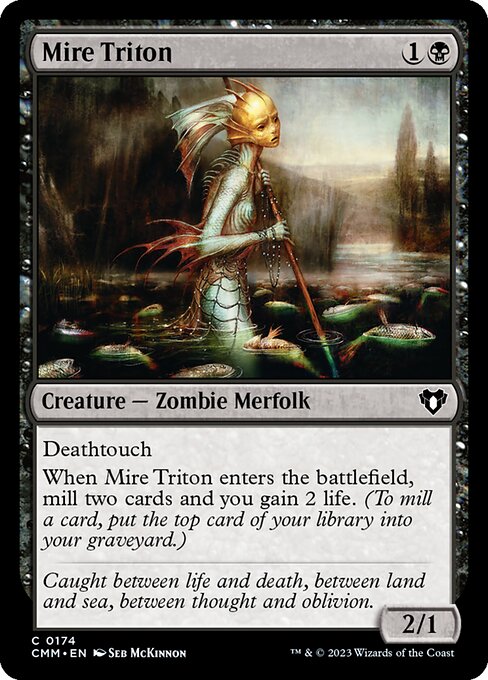
Mire Triton
Mire Triton does a few things very well: it trades with almost anything, keeps you alive, and puts a few extra cards into the graveyard—all for two mana. In Peasant cubes this feels like a shoe-in for the Spider Spawning Self-Mill deck, or a Dimir deck with several ways to get value out of the graveyard. Whatever flavor of graveyard interaction you want to acheive, Mire Triton does a damn good job of getting you there. It’s not the most effective aggressive card, but it’ll do in a pinch if you end up short on two drops, so it’s not unreasonable to think of Mire Triton as versatile. Still, I think it’s playable, but not exciting, and you’ll know what cube wants it.

Mire’s Grasp
I like Mire’s Grasp. Compare this card to Last Gasp—they share a casting cost, but are separated mostly by timing. Being an instant is no joke, and I won’t sit here and discount that. But Mire’s Grasp is also a permanent, which means it can synergize with cards like Tarmogoyf, Nissa, Vital Force, and Sun Titan. It will count towards Delirium, be brought back with Lotus-Eye Mystics, and trigger any Constellation you may have seeded into the cube. It also, of course, works great with Aphemia, the Cacophany!
Now I’ll admit this card shouldn’t be a slam dunk into your cube. Me, I’m running it for redundancy as well as for Aphemia, but it’s really not a terrible rate for your mana. If your environment wants a critical mass of cheap removal in Black, then Mire’s Grasp has some particular upside that’s worth considering.
Power Rankings—Black
Legacy/Powered
1. Aphemia, the Cacophany
2. Woe Strider
3. Eat to Extinction
4. Agonizing Remorse
Peasant
1. Elspeth’s Nightmare
2. Agonizing Remorse
3. Mire Triton
4. Mire’s Grasp
5. Drag to the Underworld
Black got a mixed bag with Theros Beyond Death. Not many of the rares stand out as real players, and few hold any significant inherent power level. I’m reasonably happy with what we got, but it’s definitely below the bar for what I’d consider an adequate selection of new cards. My expectations are certainly running higher now thanks to the Play Design Team, and with this increasing criticism comes a general disatisfaction with Black’s offerings after some testing.
Most notable here is how underwhelming the Escape cards are at lower power levels. Have any of you had success with the Escape cards besides Woe Strider? Am I setting the bar too high?
Join us next week when we go over Red! Thanks for reading.

